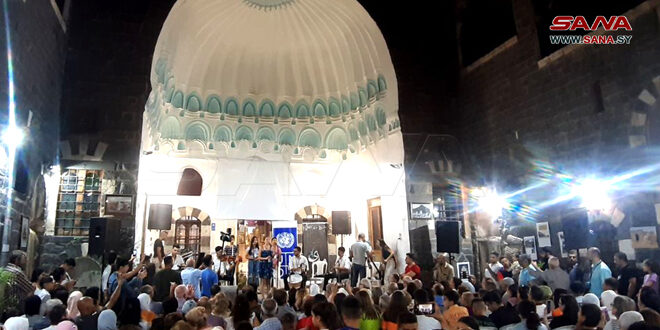An exhibition and bazaar of ancient traditional crafts and heritage evenings in a celebration at Al-Zahrawi Palace in Old Homs
The United Nations Development Program in Syria, in partnership with Homs Governorate and City Council, highlighted the archaeological landmarks in Homs through “Al-Zahrawi Palace Celebration” during the period from September 8 to 12.
The celebration comes within the framework of the community participatory planning project for Homs neighborhoods. It includes a bazaar to display the most important handicraft and traditional products related to the heritage of the governorate, paintings of archaeological landmarks from the city, and photos of its historical figures, in addition to musical and heritage performances in the courtyard of Al-Zahrawi Palace in Old Homs.
Suleiman Al-Ibrahim, the local governance officer within the United Nations Development Program for the Central Region, told SANA that the event is an initiative launched by the local community as part of the participatory planning project with Homs Governorate and the city council to highlight the beauty and importance of several archaeological landmarks in Homs, most notably Al-Zahrawi Palace, which dates back 750 years. Coordination was made with the governorate and the city council to conduct a cleaning and lighting campaign for the palace.
An introductory video was also prepared about the history of the palace and a number of traditional and heritage professions were selected to be displayed in an exhibition and bazaar, in addition to panels that highlight the archaeological landmarks of Homs and some of its historical figures, accompanied by playing musical pieces during daily heritage evenings.
Researcher Ghazi Hussein Agha, a member of the Historical Society in Homs, pointed out that the society’s pavilion included publications of the Historical Research Magazine and books about Homs, in addition to exhibits of stamps, old coins, and old manuscripts that the sheikh used to give to his students after they spent 12 years in science, education, and refinement.
Yasser Al-Sabai, head of the Fine Arts Department at the Historical Society, shed light on the section of old paintings and photos of archaeological landmarks, in addition to the section of “Folk Proverbs from Homs” which includes 24 caricatures, each of which represents a popular proverb from Homs in a drawing manner.
Khaled Khiari displayed a distinguished collection of his copper and oriental possessions, which varied between old household tools used to preserve and prepare food, pendants, daggers, coffee pots, and an old grinder for Arabic coffee.
In the heritage crafts section, Madiha Antar from the village of Al-Zara reviewed the stages of hand-woven carpets, starting with washing, combing, and braiding the wool, passing through spinning it by a group of village women in the winter, and ending with dyeing and weaving it in beautiful colors and shapes, noting the decline of the craft due to the lack of equipment and tools such as the spinning wheel and loom.
In the handicrafts bazaar, Susan Nakdali expressed her happiness to participate through a variety of gifts, pendants, and paintings made of copper wires, beads, and natural stone. She underlined the need to encourage young people to innovate new ideas and translate their creativity into reality through exhibitions and bazaars that encourage and support their creativity.
In turn, Ramez Al-Hussein, Director of the Mada Cultural Project, pointed out the participation of the “Madana Amal” band in the initiative through a musical evening that included traditional songs in a way that harmonizes with the antiquity and history of the place.
Inas Abdulkareem

